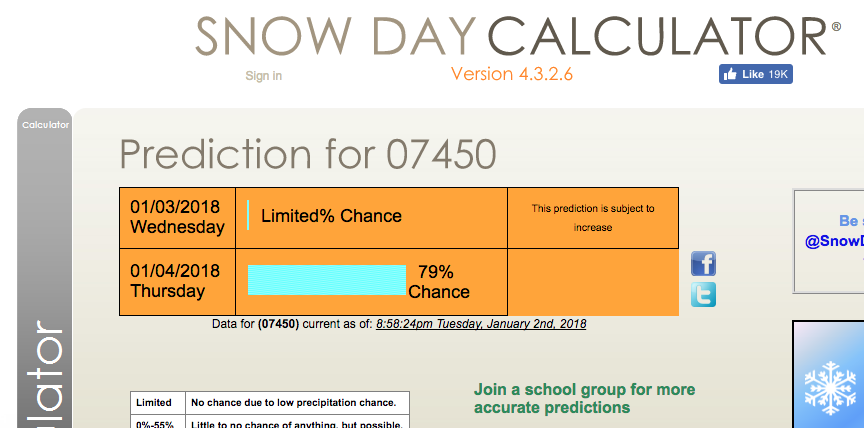
A Guide to Predicting Snow Days
Winter is a season that brings joy and excitement to many people. But, it also brings snow and ice, which can cause school closures and disrupt daily routines. One of the biggest questions that kids and parents ask during the winter season is, “Will there be a snow day tomorrow?” While there’s no surefire way to know for certain, there are a few methods you can use to predict the likelihood of a snow day.
Here are some of the most popular ways to calculate snow days:
- Check the weather forecast
The most straightforward way to predict a snow day is to check the weather forecast. If the forecast calls for heavy snow and hazardous road conditions, there’s a good chance that schools will close. Keep in mind, however, that weather can be unpredictable, and forecasts can change quickly.
- Look at the school’s snow day policy
Most schools have a policy in place for how they handle snow days. Some schools only close if there’s a certain amount of snow on the ground, while others may close if there’s any snow or ice accumulation. If you’re not sure about your school’s policy, check their website or call the school for more information.
- Keep an eye on local news and social media
Local news and social media can be a great way to stay informed about school closures and snow day predictions. Many schools will post updates on their websites and social media pages, and local news outlets will often have lists of school closures.
- Use a snow day calculator
Snow day calculators are online tools that use weather data and other information to predict the likelihood of a snow day. Some of these calculators are more accurate than others, so it’s important to check multiple calculators before making any decisions.
While these methods can help you predict the likelihood of a snow day, it’s important to remember that there’s no foolproof way to know for certain. The best thing you can do is stay informed and be prepared for the possibility of a snow day.
Define briefly Snow day calculator
Who can use a snow day calculator?
Anyone who is interested in predicting the likelihood of a snow day can use a snow day calculator. These online tools are designed for students, parents, and educators who want to stay informed about school closures due to snow and ice.
What is a snow day calculator?
A snow day calculator is an online tool that uses weather data and other information to predict the likelihood of a snow day. These calculators analyze factors such as temperature, precipitation, and wind speed to determine the chances of school closures due to snow and ice.
Where can I find a snow day calculator?
Snow day calculators can be found through a simple online search. There are many different calculators available, so it’s important to compare multiple sources to get the most accurate information.
When should I use a snow day calculator?
It’s best to use a snow day calculator in the evening or early morning, when the most recent weather data is available. This will give you the best chance of getting an accurate prediction for the next day.
Why should I use a snow day calculator?
A snow day calculator can be a helpful tool for predicting the likelihood of a snow day. By using this tool, you can stay informed and make plans accordingly, instead of waking up early to find out if school is closed.
How does a snow day calculator work?
A snow day calculator works by analyzing weather data and other information to predict the likelihood of a snow day. This data is collected from various sources, including weather forecasts and local news reports. The calculator then uses algorithms to calculate the chances of school closures based on the data it has collected.
Can a snow day calculator predict snow days with 100% accuracy?
No, a snow day calculator cannot predict snow days with 100% accuracy. Weather is unpredictable, and forecasts can change quickly. A snow day calculator can only provide a prediction based on the data it has analyzed.
Could a snow day calculator be wrong?
Yes, a snow day calculator could be wrong. This is because weather is unpredictable and can change quickly. It’s important to keep in mind that a snow day calculator is only a prediction and not a guarantee.
Would a snow day calculator be more accurate than a weather forecast?
Not necessarily. A snow day calculator is only as accurate as the data it has analyzed. It’s important to check multiple sources, including weather forecasts and local news reports, to get the most accurate information.
Should I rely solely on a snow day calculator to predict snow days?
No, it’s not a good idea to rely solely on a snow day calculator to predict snow days. While these calculators can be helpful, they are only one of many sources of information. It’s important to check multiple sources, including weather forecasts and local news reports, to get the most accurate information.
Do all schools use a snow day calculator?
No, not all schools use a snow day calculator. Some schools have their own policies for determining snow days, and others may rely on local weather forecasts and road conditions.
Does a snow day calculator take into account local road conditions?
It depends on the snow day calculator. Some calculators may take into account local road conditions, while others may only use weather data. It’s important to check the specific snow day calculator you’re using to see what information it takes into account.
Did snow day calculators exist before the internet?
No, snow day calculators did not exist before the internet. These online tools have only become available in recent years with the rise of technology and the internet.
How do you force a snow day?
Unfortunately, it is not possible to force a snow day. Snow days are usually declared by the local school district or government when the weather conditions are too severe and it is unsafe for people to travel to school or work. The decision is made based on various factors such as the amount of snow accumulation, visibility, and road conditions. The safety of students, teachers, and staff is the top priority, and the decision to cancel school is made after careful consideration. If you want to increase your chances of a snow day, you can hope for a heavy snowstorm and check the weather forecast regularly, but ultimately the decision is not in your control.
Who invented snow day calculator?
The inventor of the snow day calculator is not a specific person or entity that can be named. The concept of using technology to predict school closures due to snow and inclement weather has been around for several years, and various companies and organizations have created their own versions of a snow day calculator. These calculators typically use weather data and other factors to determine the likelihood of school closures, and can be found online or as mobile apps.
How can I increase my chances of snow day?
Unfortunately, there’s no guaranteed way to increase your chances of getting a snow day. The decision to close schools or cancel work due to inclement weather is usually made by local authorities, such as school boards or city governments, based on various factors such as the severity of the weather conditions, the safety of people traveling to and from work or school, and the ability of public services and utilities to function normally. To increase your chances of getting a snow day, you might consider monitoring the local weather forecasts and road conditions closely, and advocating for the closure of schools or workplaces if you feel that it’s necessary for safety reasons. However, ultimately, the decision to declare a snow day is out of your control.
Can you make it snow in real life?
Is snow day calculator accurate?
Snow day calculators can provide an estimate of the likelihood of a school closing or delay due to snow, but they are not always accurate. The accuracy of a snow day calculator can vary depending on the data sources it uses, the algorithms it employs, and the complexity of the weather conditions being predicted. It is important to remember that a snow day calculator is not an official announcement, and the final decision to close or delay a school due to snow is made by the school district or local government.
How accurate is snow day calculator?
The accuracy of snow day calculators can vary, but some may be more accurate than others. The accuracy depends on factors such as the quality of the data sources used, the sophistication of the algorithms employed, and the complexity of the weather conditions being predicted. Some snow day calculators may provide more accurate predictions than others, but no snow day calculator can guarantee 100% accuracy.
Is the snow day calculator accurate?
The accuracy of the snow day calculator can vary, and it is important to remember that it is only an estimate and not an official announcement. The final decision to close or delay a school due to snow is made by the school district or local government.
How does snow day calculator work?
Snow day calculators work by using a variety of data sources, including weather forecasts, snow accumulation predictions, and temperature readings, to estimate the likelihood of a school closing or delay due to snow. Some snow day calculators also use historical data to make more accurate predictions. The specific algorithm and data sources used by a snow day calculator can influence its accuracy.
How to make a snow day calculator?
To make a snow day calculator, you would need a programming language such as Python, along with access to weather data and algorithms to process that data. The specific steps to create a snow day calculator will vary depending on the data sources you use and the algorithms you employ, but you can start by researching existing snow day calculators and using that information as a guide.
Who made the snow day calculator?
It is not possible to identify the person or organization who created the first snow day calculator, as there are many different snow day calculators available online, and it is likely that multiple calculators were developed independently by different people or organizations.
Who runs snow day calculator?
The specific person or organization responsible for running a snow day calculator will vary, as there are many different snow day calculators available online. Some snow day calculators may be run by private individuals or organizations, while others may be maintained by government agencies or educational institutions.
Will I have a snow day calculator? The availability of a snow day calculator depends on where you live and the school or educational institution you attend. Some schools or educational institutions may have their own snow day calculator, while others may rely on publicly available calculators. It’s best to check with your school or educational institution to see if they have their own snow day calculator.
Will it be a snow day calculator?
It is not possible to determine whether or not it will be a snow day without official information from your school or educational institution. Snow day calculators are only an estimate and are not an official announcement. The final decision to close or delay a school due to snow is made by the school district or local government.
Will there be a snow day calculator?
The availability of a snow day calculator depends on the specific school or educational institution you attend. Some schools or educational institutions may have their own snow day calculator, while others may rely on publicly available calculators. It’s best to check with your school or educational institution to see if they have their own snow day calculator.
How does Snow Day Calculator work?
When was snow first seen?
The exact date of the first snowfall is not known, as snow is a natural occurrence that has likely been happening since the formation of Earth. It is possible that snow has been falling since the Earth’s climate was cool enough to support it. The earliest evidence of snow and ice accumulation on Earth comes from ice cores that date back over 800,000 years.
When was fake snow invented?
The exact date of the invention of fake snow is unclear, but its use for various purposes such as decorations, stage productions, and films has been reported since the early 20th century. Synthetic snow, made from materials like polyvinyl chloride (PVC) and polyethylene, is used as a substitute for real snow in areas where it is not available or as a more practical alternative for certain applications. The development of fake snow has continued to evolve, and today there are many different types of synthetic snow products with varying degrees of realism and durability.
How do you calculate how much snow will fall?
Calculating the amount of snow that will fall is a challenging task, as it depends on many variables, including temperature, moisture, wind patterns, and other atmospheric conditions. The following are some of the methods used to estimate the amount of snowfall:
- Meteorological models:
National Weather Services and other meteorological organizations use complex computer models that take into account the various atmospheric conditions to make predictions about snowfall. These models can provide accurate snowfall forecasts for specific locations, taking into account local variations in terrain, temperature, and other factors.
- Snow ratios:
Meteorologists can also use snow ratios to estimate snowfall. A snow ratio is the ratio of the amount of snow that falls to the amount of liquid precipitation that would have fallen if the temperature was above freezing. For example, a 10:1 snow ratio means that for every inch of liquid precipitation, 10 inches of snow will fall.
- Ground observations:
Meteorologists may also use ground observations, such as snow depth measurements taken by trained observers, to estimate the amount of snowfall. This can be especially helpful for areas where the snowfall is heavy or for locations that are difficult to access with meteorological equipment.
- Remote sensing:
Modern satellites and radar systems can also provide valuable information about snowfall. For example, weather radars can detect the presence of snow in the atmosphere and estimate its intensity, while satellites can provide a broader view of the extent and distribution of snow cover.
It’s important to note that while these methods can provide good estimates of snowfall, they are not always 100% accurate. Snowfall is a complex and unpredictable weather phenomenon, and even the most advanced meteorological models and techniques can only provide an estimate.
How do you calculate snow ratio?
Snow ratio is calculated by dividing the amount of snowfall by the amount of liquid precipitation that would have fallen if the temperature was above freezing. Here’s an example of how to calculate snow ratio:
Suppose that during a snowstorm, 10 inches of snowfall was measured and the liquid equivalent of the snowfall is 2 inches. To calculate the snow ratio, divide the amount of snowfall by the liquid equivalent:
Snow ratio = 10 inches of snow ÷ 2 inches of liquid precipitation = 5:1
So, in this example, the snow ratio is 5:1, meaning that for every inch of liquid precipitation, 5 inches of snow will fall.
It’s important to note that snow ratios can vary greatly depending on the atmospheric conditions at a given location. For example, a higher snow ratio can indicate a more severe snowstorm, while a lower snow ratio might suggest a more moderate snowfall. Snow ratios can also be used to estimate snowfall amounts based on the amount of liquid precipitation that would have fallen, which can be useful for making planning and preparedness decisions.
conclusion
In , a snow day is an exciting and unpredictable event that many kids and parents look forward to during the winter season. By using these methods, you can get a better idea of whether or not a snow day is on the horizon. But, it’s always best to be prepared for the possibility of a snow day, no matter what the weather forecast says.






